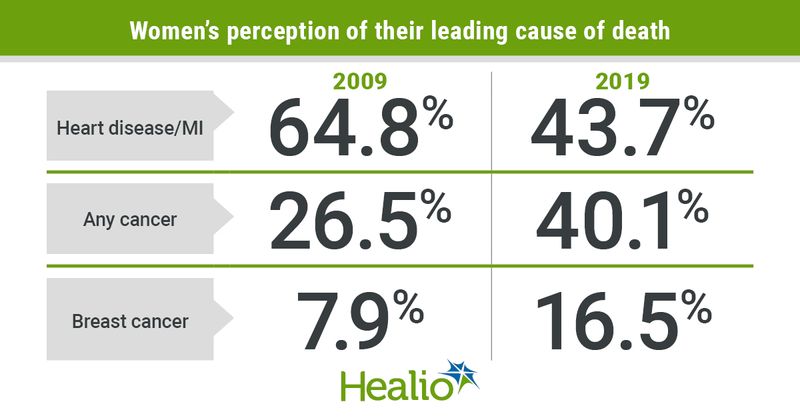AHA: Awareness of heart disease as leading cause of death in women declined from 2009
Awareness on the leading cause of death in women — heart disease — declined from 2009 to 2019, particularly in non-Hispanic Black and Hispanic women, and in younger women, an American Heart Association survey found.
Findings from the 2019 AHA Survey of Women’s Cardiovascular Disease Awareness were published in Circulation.

Source: Cushman M, et al. Circulation. 2020;doi:10.1161/CIR.0000000000000907.
“This is brand-new knowledge that we are going in the wrong direction when it comes to women’s heart health awareness, especially in younger women and women of color who were less likely than other women to be aware that heart disease is the leading cause of death,” Mary Cushman, MD, MSc, FAHA, professor of medicine at the University of Vermont Larner College of Medicine in Burlington and chair of the writing group, told Healio. “The finding that women with hypertension were less aware of this fact than women without hypertension was stunning, considering that hypertension is the most common heart disease risk factor.”
Efforts to increase awareness
Nearly 28% of deaths in women were caused by heart disease and stroke, according to the background portion of the publication. Several awareness programs have been created to educate people about CVD in U.S. such as Go Red for Women by the AHA; Make the Call, Don’t Miss a Beat by HHS; and The Heart Truth by the NHLBI.
This online survey, which was conducted to assess 10-year differences in awareness, was completed by 1,553 women (mean age, 50 years) in the U.S. aged at least 25 years. Several questions focused on CVD such as awareness of the leading cause of death in women, CVD-related medical history, warning signs of MI and first actions to take for MI.

“AHA conducts these surveys of women about every 3 years to monitor trends,” Cushman said in an interview. “This will help AHA and all stakeholders understand where improvements can be made in education. Awareness is the first step to prevention of disease (ie, knowing why it is important to quit smoking or get your blood pressure checked), and survival if the disease should develop (ie, knowing to call 911 if you have chest pain).”
Data collected from the survey were weighed by race/ethnicity, age, income, educational attainment and region to reflect the composition of the U.S. population.
Awareness of heart disease as the leading cause of death decreased from 65% in 2009 to 44% in 2019.
Awareness of the leading cause of death in women, according to the 2019 survey, was greater with increasing education and older age, and lower in women with hypertension and women of color.
Declines in awareness during this 10-year period were observed in all ages and races/ethnicities except for women aged at least 65 years. Researchers observed the greatest declines from 2009 to 2019 in non-Hispanic Black women (OR = 0.31; 95% CI, 0.19-0.49), Hispanic women (OR = 0.14; 95% CI, 0.07-0.28) and in women aged 25 to 34 years (OR = 0.19; 95% CI, 0.1-0.34).
Compared with 2009, women in 2019 were more likely to incorrectly identify breast cancer as the leading cause of death (OR = 2.59; 95% CI, 1.86-3.67). This association was greater in younger women compared with other groups.
Fewer women were able to identify possible warning signs of MI in 2019 compared with 2009, which was observed in the overall group and within each racial/ethnic group. The difference in identifying warning signs of MI was statistically significant in the overall group, in addition to non-Hispanic white women, who identified seven of 13 MI symptoms, and in non-Hispanic Black and Hispanic women, who identified three symptoms.
“Health care providers need to have discussions with women about their leading cause of death at all ages,” Cushman told Healio. “These discussions naturally lead to discussion about how to prevent the disease. We believe 80% of heart disease can be prevented, but only through education and adoption of healthy lifestyle and risk factor prevention and control. Every 80 seconds, a woman dies of heart disease.”
Future actions
Cushman told Healio that more must be done to improve awareness, even outside of the clinical setting. “Health care providers need to talk about it with their patients, but moreover, it should be discussed everywhere people live, work, play and pray,” she said. “All of us can help fix the misconceptions of that when the next AHA survey is done, we see a turnaround in these results. Women tend to care for others before themselves, but they just need to be more aware of their own self-care. Special work needs to be done in reaching younger women and women of color.”
For more information:
Mary Cushman, MD, MSc, FAHA, can be reached at mary.cushman@med.uvm.edu; Twitter: @marycushmanmd.

